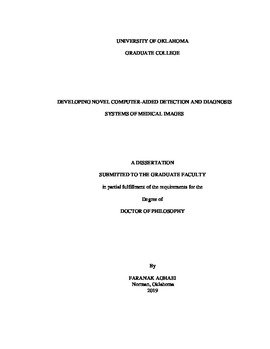| dc.description.abstract | Reading medical images to detect and diagnose diseases is often difficult and has large inter-reader variability. To address this issue, developing computer-aided detection and diagnosis (CAD) schemes or systems of medical images has attracted broad research interest in the last several decades. Despite great effort and significant progress in previous studies, only limited CAD schemes have been used in clinical practice. Thus, developing new CAD schemes is still a hot research topic in medical imaging informatics field. In this dissertation, I investigate the feasibility of developing several new innovative CAD schemes for different application purposes. First, to predict breast tumor response to neoadjuvant chemotherapy and reduce unnecessary aggressive surgery, I developed two CAD schemes of breast magnetic resonance imaging (MRI) to generate quantitative image markers based on quantitative analysis of global kinetic features. Using the image marker computed from breast MRI acquired pre-chemotherapy, CAD scheme enables to predict radiographic complete response (CR) of breast tumors to neoadjuvant chemotherapy, while using the imaging marker based on the fusion of kinetic and texture features extracted from breast MRI performed after neoadjuvant chemotherapy, CAD scheme can better predict the pathologic complete response (pCR) of the patients. Second, to more accurately predict prognosis of stroke patients, quantifying brain hemorrhage and ventricular cerebrospinal fluid depicting on brain CT images can play an important role. For this purpose, I developed a new interactive CAD tool to segment hemorrhage regions and extract radiological imaging marker to quantitatively determine the severity of aneurysmal subarachnoid hemorrhage at presentation and correlate the estimation with various homeostatic/metabolic derangements and predict clinical outcome. Third, to improve the efficiency of primary antibody screening processes in new cancer drug development, I developed a CAD scheme to automatically identify the non-negative tissue slides, which indicate reactive antibodies in digital pathology images. Last, to improve operation efficiency and reliability of storing digital pathology image data, I developed a CAD scheme using optical character recognition algorithm to automatically extract metadata from tissue slide label images and reduce manual entry for slide tracking and archiving in the tissue pathology laboratories.
In summary, in these studies, we developed and tested several innovative approaches to identify quantitative imaging markers with high discriminatory power. In all CAD schemes, the graphic user interface-based visual aid tools were also developed and implemented. Study results demonstrated feasibility of applying CAD technology to several new application fields, which has potential to assist radiologists, oncologists and pathologists improving accuracy and consistency in disease diagnosis and prognosis assessment of using medical image. | en_US |
